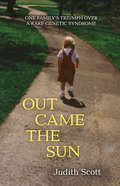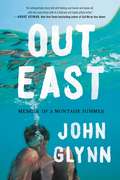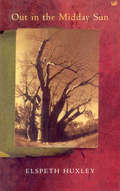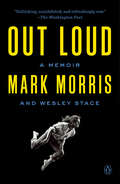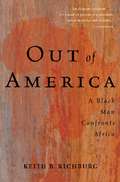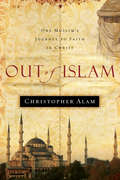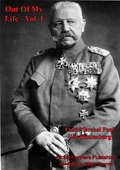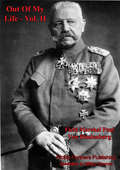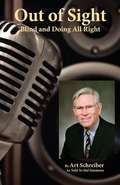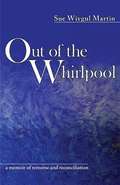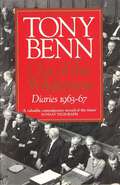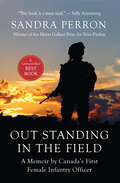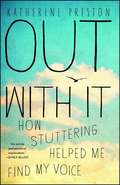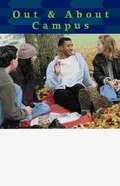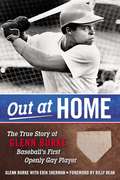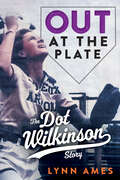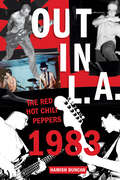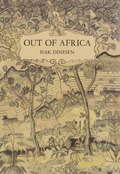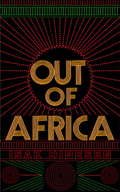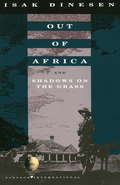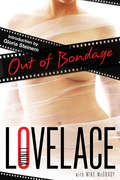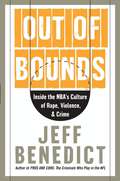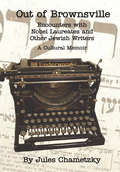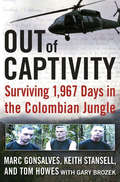- Table View
- List View
Out Came the Sun: One Family's Triumph over a Rare Genetic Syndrome
by Judith ScottSix years into their marriage, Judith and Greg Scott decided to have a child; they were blessed with the birth of beautiful Emily. But their euphoria was short lived when their child was diagnosed with a rare and disabling condition: Partial Trisomy 13. Emily, they were told, would never walk, talk or read. From this tragic beginning unfolds the astonishing, life-altering journey of Out Came the Sun. Emily struggles to learn life's simple tasks, lagging far behind her peers. And the strains on her parents' marriage nearly cause it to come apart at the seams. But when Emily starts exceeding her doctor's expectations, Judith realizes that she too can overcome adversity by opening her life to more love and more children. This riveting, beautiful memoir demonstrates that extraordinary fortitude requires to take misfortune and valiantly turn it into triumph.
Out East: Memoir of a Montauk Summer
by John GlynnAn "extraordinary" debut memoir of first love, identity, and self-discovery among a group of friends who became family in a Montauk summer house (Andrew Solomon, National Book Award winner).They call Montauk the end of the world, a spit of land jutting into the Atlantic. The house was a ramshackle split-level set on a hill, and each summer thirty-one people would sleep between its thin walls and shag carpets. Against the moonlight the house's octagonal roof resembled a bee's nest. It was dubbed The Hive.In 2013, John Glynn joined the share house. Packing his duffel for that first Memorial Day Weekend, he prayed for clarity. At twenty-seven, he was crippled by an all-encompassing loneliness, a feeling he had carried in his heart for as long as he could remember. John didn't understand the loneliness. He just knew it was there. Like the moon gone dark.Out East is the portrait of a summer, of The Hive and the people who lived in it, and John's own reckoning with a half-formed sense of self. From Memorial Day to Labor Day, The Hive was a center of gravity, a port of call, a home. Friendships, conflicts, secrets and epiphanies blossomed within this tightly woven friend group and came to define how they would live out the rest of their twenties and beyond. Blending the sand-strewn milieu of George Howe Colt's The Big House with the radiant aching of Olivia Liang's The Lonely City, Out East is a keenly wrought story of love and transformation, longing and escape in our own contemporary moment."An unforgettable story told with feeling and humor and above all with the razor-sharp skill of a delicate and highly gifted writer." -- André Aciman, New York Times bestselling author of Call Me by Your Name"Out East is full of intimacy and hope and frustration and joy, an extraordinary tale of emotional awakening and lacerating ambivalence, a confession of self-doubt that becomes self-knowledge." -- Andrew Solomon, National Book Award winnerAn Entertainment Weekly Best Book of May 2019A Time magazine Best Book of May 2019Cosmopolitan Best Book of May 2019An O, the Oprah Magazine Best LGBTQ Book of 2019
Out In The Midday Sun
by Elspeth HuxleyElspeth Huxley captivated readers throughout the world with her 'memories of an African childhood' in THE FLAME TREES OF THIKA and THE MOTTLED LIZARD. In this final volume of her trilogy she tells the story of her adult life in Africa, in which the vigorously evoked personalities - from the pioneer Lord Delamere and Baroness Blixen to Jomo Kenyatta - blend with her supurb description of the social, cultural and political upheavals of the time. 'An accomplished story-teller, she weaves anecdotes, character sketches, political history together without losing her thread or the readers momentum. ' SUNDAY TIMES 'She evokes it all lovingly but astringently, especially the glittering, often scandelous life of the young aristocrats who lived in Happy Valley. ' DAILY EXPRESS
Out Loud: A Memoir
by Mark Morris Wesley StaceFrom the most brilliant and audacious choreographer of our time, the exuberant tale of a young dancer’s rise to the pinnacle of the performing arts world, and the triumphs and perils of creating work on his own terms—and staying true to himself Before Mark Morris became “the most successful and influential choreographer alive” (The New York Times), he was a six year-old in Seattle cramming his feet into Tupperware glasses so that he could practice walking on pointe. Often the only boy in the dance studio, he was called a sissy, a term he wore like a badge of honor. He was unlike anyone else, deeply gifted and spirited. Moving to New York at nineteen, he arrived to one of the great booms of dance in America. Audiences in 1976 had the luxury of Merce Cunningham’s finest experiments with time and space, of Twyla Tharp’s virtuosity, and Lucinda Childs's genius. Morris was flat broke but found a group of likeminded artists that danced together, travelled together, slept together. No one wanted to break the spell or miss a thing, because “if you missed anything, you missed everything.” This collective, led by Morris’s fiercely original vision, became the famed Mark Morris Dance Group. Suddenly, Morris was making a fast ascent. Celebrated by The New Yorker’s critic as one of the great young talents, an androgynous beauty in the vein of Michelangelo’s David, he and his company had arrived. Collaborations with the likes of Mikhail Baryshnikov, Yo-Yo Ma, Lou Harrison, and Howard Hodgkin followed. And so did controversy: from the circus of his tenure at La Monnaie in Belgium to his work on the biggest flop in Broadway history. But through the Reagan-Bush era, the worst of the AIDS epidemic, through rehearsal squabbles and backstage intrigues, Morris emerged as one of the great visionaries of modern dance, a force of nature with a dedication to beauty and a love of the body, an artist as joyful as he is provocative. Out Loud is the bighearted and outspoken story of a man as formidable on the page as he is on the boards. With unusual candor and disarming wit, Morris’s memoir captures the life of a performer who broke the mold, a brilliant maverick who found his home in the collective and liberating world of music and dance.
Out Of America: A Black Man Confronts Africa
by Keith B. RichburgNothing in Keith Richburg's long and respected journalistic career at the Washington Post prepared him for what he would encounter as the paper's correspondent in Africa. He found a continent where brutal murder had become routine, where dictators and warlords silenced dissent with machine guns and machetes, and where starvation had become depressingly common. With a great deal of personal anguish, Richburg faced a difficult question: If this is Africa, what does it mean to be an African American?In this provocative and unvarnished account of his three years on the continent of his ancestors, Richburg takes us on a extraordinary journey that sweeps from Somalia to South Africa, showing how he confronted the divide between his African racial heritage and his American cultural identity.
Out Of Islam: One Muslim's Journey to Faith in Christ
by Christopher AlamClick Here For Sample ChapterChristopher Alam&’s life and ministry have been filled with one adventure and miraculous event after another. Out of Islam traces the adventures of Alam as a young Pakistani convert to Christianity from a traditional Muslim family to his emergent worldwide evangelistic and healing ministry. With his father being a devout Muslim and lifelong military officer who once trained fighters alongside Osama bin Laden, and his mother an India-born performing artist, Alam knew a privileged life that few experience. After Alam&’s conversion, his father had him arrested and sought to have him beheaded for betraying the family faith. Through a series of miraculous events, Alam ultimately escaped to Sweden, where he met and married his wife, Britta. Together they have launched their ministry, which has been praised by evangelist Reinhard Bonnke, the late Kenneth E. Hagin, and Ray McCauley. Alam has preached in more than sixty nations, with millions making firsttime decisions for Christ and hundreds of new churches started. This book will encourage the hearts of readers to rise above hardships and move into the supernatural manifestations of the Holy Spirit, while offering faith lessons for evangelists. About the AuthorChristopher Alam is founder and director of Christopher Alam Ministries International, also known as Dynamis World Ministries, which has a full-time crusade team on the field in Africa and numerous evangelists and church-planters working in Asia.
Out Of My Life, By Marshal Von Hindenburg. Vol. I (Out Of My Life #1)
by F. A. Holt Field-Marshal Paul von HindenburgField-Marshal Paul von Hindenburg is a well-known figure to world history; the supreme war-lord of Germany for many years of the First World War and conservative figure-head of the post-war Germany. Although not of noble birth he rose through the ranks of the pre-war Prussian army, seeing much service in the Prussian-Austrian war of 1866 and the Franco-Prussian war of 1870. He believed his career over and retired in 1913 before being reactivated for the conflict that would become the First World War. He was assigned to the Eastern Front to combat the Russian armies. Forging a successful partnership with his staff officers, such as Max Hoffmann and Erich Ludendorff who dealt with much of the operational planning, he won the epic victories over the Russians at the battles of Tannenberg and the Masurian Lakes. Feted as a national hero after these victories and further successes in 1915, he was summoned to take charge on the Western front in 1916. He would mastermind the defensive strategy of the German army in 1916 and 1917 before committing the Germany army to the last throw of the dice in the 1918 German offensive.His memoirs are essential reading for anyone interested in the motivations of the German High command during the First World War. This first volume begins with his early military career up to his assumption of the post of the Chief of the General Staff in 1918.Author -- Field-Marshal von Hindenburg, Paul, 1847-1934.Translator -- F. A. Holt.Text taken, whole and complete, from the edition published in New York, Harper & brothers 1921Original Page Count - 267 pages.Illustrations -- 1 Portrait
Out Of My Life, By Marshal Von Hindenburg. Vol. II (Out Of My Life #2)
by F. A. Holt Field-Marshal Paul von HindenburgField-Marshal Paul von Hindenburg is a well-known figure to world history; the supreme war-lord of Germany for many years of the First World War and conservative figure-head of the post-war Germany. Although not of noble birth he rose through the ranks of the pre-war Prussian army, seeing much service in the Prussian-Austrian war of 1866 and the Franco-Prussian war of 1870. He believed his career over and retired in 1913 before being reactivated for the conflict that would become the First World War. He was assigned to the Eastern Front to combat the Russian armies. Forging a successful partnership with his staff officers, such as Max Hoffmann and Erich Ludendorff who dealt with much of the operational planning, he won the epic victories over the Russians at the battles of Tannenberg and the Masurian Lakes. Feted as a national hero after these victories and further successes in 1915, he was summoned to take charge on the Western front in 1916. He would mastermind the defensive strategy of the German army in 1916 and 1917 before committing the Germany army to the last throw of the dice in the 1918 German offensive.His memoirs are essential reading for anyone interested in the motivations of the German High command during the First World War. This second volume carries on his narrative from assumption of the quasi-dictatorship up to the end of the war.Author -- Field-Marshal von Hindenburg, Paul, 1847-1934.Translator -- F. A. Holt.Text taken, whole and complete, from the edition published in New York, Harper & brothers 1921Original Page Count - 296 pages.Illustrations -- 1 Portrait
Out Of Sight: Blind And Doing All Right
by Art Schreiber Hal SimmonsA high level radio news broadcast executive, Art Schreiber suddenly lost his eyesight. At the top of his career as a radio station general manager, Art awoke one morning at a resort near Santa Fe, New Mexico, unable to see. His world was in complete darkness. After facing total despair, Art plotted his return to the top while learning to live life in a new way in a new world. Art's refusal to fold his tent when his eyesight failed and his struggle to live life to the fullest will inspire any person who reads his story. Art's greatest reward in life is encouraging and motivating others who face similar challenges.
Out Of The Whirlpool: A Memoir Of Remorse And Reconciliation (2nd Edition)
by Sue Wiygul MartinSue Wiygul Martin has written a deeply honest and moving account of the rebuilding of her life after a desperate, impetuous act in her youth ended in traumatic blindness. Since that day, she has greeted the world with her trademark determination and humor, accepting the challenges placed before her as she adjusted to being blind. She takes the reader through the process of blind rehabilitation in such a way that you feel you, too, are going through the process of learning new skills and making the emotional adjustment right along with her. You come to understand what it takes to rebuild a life after a traumatic episode that upends your world of dreams and expectations. Now, after more than thirty years of an extraordinary recovery and reconciliation with the past, Martin is ready to share the simple truth of her journey. Advance readers have called her book a "Must read" for anyone in the field of blind rehab or anyone going through the adjustment to new blindness or other traumatic events in their lives. Martin's truth is a universal truth, one which is so easy to lose sight of--we are all the same, yet so beautifully different. So, fasten your seat belts. Sue Martin would like to take you on a wild ride through this life of hers. Get ready for some joy, sorrow, beauty, a few cosmic slaps of enlightenment, and a thousand other thoughts and feelings along the way. Filled with adventure, with joy, and triumph, with adversity and adjustment to change, Out of the Whirlpool is a story about living life to the fullest. While she may have faced extraordinary challenges, in the end, she will tell you her story is everyone's story.
Out Of The Wilderness: Diaries 1963-67
by Tony Benn1963 saw Labour's emergence from its 'wilderness years' in Opposition, and the election of Harold Wilson following the unexpected death of Hugh Gaitskell. In the first Wilson government of 1964 Benn was made Postmaster General and became known as an innovator for his introduction of the Giro and arguing for a radical broadcasting policy. After Labour's landslide victory of 1966 he was appointed to the Cabinet as Minister of Technology, but Labour's honeymoon came to an abrupt end in 1967 with the introduction of devaluation, leading to disilliusionment with the Government.Tony Benn's account on his relations with the industrialists, television and press chiefs, the Palace and the diplomatic world as well as trade unionists, civil servants, and his Cabinet colleagues, reveals the workings of our political and economic systems at the highest level.Out of the Wilderness is a unique political record of the 1960s, told by a man who served in five Labour administrations and who today is one of the most experienced figures both in and out of the House of Commons.'No-one interested in the political influence of the Crown, the intrigues of the civil service or the highly traditionalist character of Harold Wilson can afford to ignore it' The Observer
Out Standing in the Field: A Memoir by Canada's First Female Infantry Officer
by Sandra PerronSome books are catalysts. Shake Hands with the Devil was one. For 2017, that book is Out Standing in the Field. In her memoir, Sandra Perron describes her experience of the Canadian Military - one of the most important institutions of our nation. What she has to say is exactly what the top brass has been paying lip-service to for years, and doing nothing to improve. In 2016, the Auditor General's Report noted that the military had no strategy to recruit women, even though they are required to meet a target that 25% of the uniformed personnel be women. According to Statistics Canada, 1,000 members of our military say they have been sexually assaulted in the past year. In her revealing and moving memoir, Sandra Perron, Canada's first female infantry officer and a member of the Royal 22e Régiment - the legendary "Van Doos" - describes her fight against a system of institutional sexism. Though repeatedly identified as top of her class throughout her training, she was subject to harassment by her male colleagues. Her military experience, however, wasn't all negative. Through two deployments to Bosnia and Croatia, Perron forged lasting friendships with men and women, serving her country with courage and compassion, and her determination helped pave the way for women's inclusion in the Armed Forces. Out Standing in the Field is the story of a soldier who refused to let her comrades or her country down, even while serving a military institution that failed her repeatedly. Beautifully written, Perron's memoir is a testament to her fortitude and patriotism, and serves as proof that the spirit of a true hero cannot be bent or broken.
Out With It
by Katherine PrestonA vividly powerful memoir of a young woman who fought for years to change who she was until she finally found her voice and learned to embrace her imperfection. Imagine waking up one day to find your words trapped inside your head, leaving you unable to say what you feel, think, want, or need. At the age of seven that happened to Katherine Preston. From that moment, she began battling her stutter and hiding her shame by denying there was anything wrong. Seventeen years later, exhausted and humiliated, she made a life-changing decision: to leave her home in London and spend a year traveling around America meeting hundreds of stutterers, speech therapists, and researchers. What began as a vague search for a cure became a journey that debunked the misconceptions shrouding the condition, and a love story that transformed her conception of what it means to be normal. Shedding light on an ancient condition that affects approximately 4 million people in the United States and 60 million people worldwide, Preston has assembled an anthology of expertise and experience. In addition to specialists in the field, she interviews celebrities, writers, musicians, social workers, psychologists, and financiers--men and women from all walks of life battling their difficulties with speech. A heartwarming memoir and a journalistic feat, Out With It is more than a chronicle of one of the most prevalent speech problems in the world; it's a story about understanding yourself, and learning to embrace the voice within.
Out and About Campus: Personal Accounts by Lesbian, Bisexual, and Transgendered College Students
by Kim Howard Annie StevensPersonal accounts of LBGT college students from around the U.S.
Out at Home
by Erik Sherman Glenn BurkeBefore Jason Collins, before Michael Sam, there was Glenn Burke. By becoming the first—and only—openly gay player in Major League Baseball, Glenn would become a pioneer in his own way, nearly thirty years after another black Dodger rookie, Jackie Robinson, broke the league’s color barrier. This is Glenn’s story, in his own words . . . <p><p> Touted by scouts and coaches alike as “the next Willie Mays,” Burke, a charismatic outfielder, kept his sexuality off the radar for a good two seasons, which included a World Series appearance. He was even credited with inventing the high five with teammate Dusty Baker. <p> But when the Dodgers’ front office got wind of Burke’s sexuality, the damage control started, including efforts by upper management to talk him into a sham marriage. When Burke refused, he was eventually traded to Oakland, where he received a less-than-warm welcome from incoming manager Billy Martin. The prejudice, coupled with an injured knee, forced Burke into retirement at only twenty-seven years old. <p> Now, two decades after his death from AIDS-related complications, the man who started the conversation is finally being included in it. Major League Baseball recognized him as a gay pioneer at the 2014 All-Star game. And Burke has become a source of inspiration for athletes who refuse to be defined by who they love, while doing what they love. <p> Includes a new afterword by coauthor Erik Sherman reflecting on the two decades that have passed since Burke’s death.
Out at the Plate: The Dot Wilkinson Story
by Lynn Ames"Dot Wilkinson is the greatest female catcher ever to play softball. A bold, pioneering athlete, she refused to let others define her and instead defined herself. Her story is an inspiration to people everywhere." —Billie Jean King, Sports Icon and Champion for Equality It's not simply that Dot Wilkinson was one of the most decorated women's softball players, bowlers, and athletes of all time and one of the original players from the three-time-world-champion PBSW Phoenix Ramblers softball team (1933–1965). Nor was it the length of her time here on Earth—over a century—although any of these things by itself would be impressive. The magic of Dot's story is in the details. It's the tale of a childhood spent in poverty, an indomitable, unbreakable spirit, a determination to be the very best to play whatever sport she undertook, the independence to live her personal life on her own terms, and her tremendous success at all of it. Over more than a decade of countless conversations and interviews, Dot shared all of it with her dear friend, author Lynn Ames. Dot held nothing back. Out at the Plate, told through the lens of Dot and Lynn's friendship, is the story of a forgotten era in women's history and sports, and one extraordinary woman's place at the center of it all.
Out in L.A.: The Red Hot Chili Peppers, 1983
by Hamish DuncanThe Red Hot Chili Peppers were going to be a one-time act for a friend's album release party. Forty years later the funk rock band is arguably one of the best known and the longest running in the United States. Everything that happened in 1983 set the course for the rest of the band's career. The scrappy band quickly rose to scene-wide fame, playing all over Los Angeles and gaining fans and media attention wherever they performed. Before the year was out, they had played approximately thirty shows, put together an early, beloved repertoire, recorded a blistering demo that secured them a recording contract with EMI/Enigma, and lost two of their founding members to a rival band.Out in L.A. is an attempt at finding out exactly what happened during that first year and exploring what it is that makes the Red Hot Chili Peppers so compelling and fresh, even as they continue on their musical journey today.
Out of Africa
by Isak DinesenIn this book, the author of Seven Gothic Tales gives a true account of her life on her plantation in Kenya. She tells with classic simplicity of the ways of the country and the natives: of the beauty of the Ngong Hills and coffee trees in blossom: of her guests, from the Prince of Wales to Knudsen, the old charcoal burner, who visited her: of primitive festivals: of big game that were her near neighbors--lions, rhinos, elephants, zebras, buffaloes--and of Lulu, the little gazelle who came to live with her, unbelievably ladylike and beautiful.The Random House colophon made its debut in February 1927 on the cover of a little pamphlet called "Announcement Number One." Bennett Cerf and Donald Klopfer, the company's founders, had acquired the Modern Library from publishers Boni and Liveright two years earlier. One day, their friend the illustrator Rockwell Kent stopped by their office. Cerf later recalled, "Rockwell was sitting at my desk facing Donald, and we were talking about doing a few books on the side, when suddenly I got an inspiration and said, 'I've got the name for our publishing house. We just said we were go-ing to publish a few books on the side at random. Let's call it Random House.' Donald liked the idea, and Rockwell Kent said, 'That's a great name. I'll draw your trademark.' So, sitting at my desk, he took a piece of paper and in five minutes drew Random House, which has been our colophon ever since." Throughout the years, the mission of Random House has remained consistent: to publish books of the highest quality, at random. We are proud to continue this tradition today.This edition is set from the first American edition of 1937 and commemorates the seventy-fifth anniversary of Random House.From the Hardcover edition.
Out of Africa
by Isak DinesenAn enthralling depiction of the waning years of British colonial power. Out of Africa recounts the experiences of Baroness Karen von Blixen-Finecke in what was then British East Africa, now called Kenya. Blixen and her husband build a coffee plantation and staff it with local workers. At first things seems idyllic, but as the memoir progresses it traces the descent and ultimate failure of both the marriage and the plantation. It was adapted into a film in 1985, starring Meryl Streep and Robert Redford. Penguin Random House Canada is proud to bring you classic works of literature in e-book form, with the highest quality production values. Find more today and rediscover books you never knew you loved.
Out of Africa: and Shadows on the Grass (Vintage International)
by Isak DinesenWith classic simplicity and a painter's feeling for atmosphere and detail, Isak Dinesen tells of the years she spent from 1914 to 1931 managing a coffee plantation in Kenya.
Out of Bondage
by Linda Lovelace Mike McGradyThe Deep Throat star&’s raw account of life after leaving the porn industry, featuring an introduction by feminist icon Gloria Steinem.Portrayed by today&’s biggest movie stars, screen legend Linda Lovelace was just twenty-three when she became the queen of porn in the blockbuster movie Deep Throat. Her bestselling memoir Ordeal laid bare the nightmare of terror, rape and perversity she suffered during the making of the film. Now she tells the harrowing and compelling story of how she survived to build a different kind of life. In her own candid words, Linda describes her escape from a brutal past to become a wife and mother, proving she could be more than a sex object who spent her days in fear. Step by step she gained control of her own future. Honest, at times shocking, and in the end inspiring, this is an unforgettable portrait of a woman who learned to believe in herself.
Out of Bounds: Inside the NBA's Culture of Rape, Violence, & Crime
by Jeff BenedictOut of Bounds: Inside the NBA's Culture of Rape, Violence, and Crime is a searing indictment of professional basketball players who live in a world where criminal laws and social norms don't exist, a world where they are given license to act above the law.On the court, they dazzle us with their spectacular physical feats. They generate millions of dollars of revenue for the NBA and their teams. They inspire adulation. But underneath all the glitz, the money, and alley-oops is a seamy underbelly, a rash of lawlessness that is gripping the NBA.Based on a first-of-its-kind investigation into the criminal histories of 177 NBA players from the 2001–2002 season, Out of Bounds shows that an alarming four out of every ten NBA players have a police record involving a serious crime. They are All-Stars and they are journeymen, involved in crimes ranging from armed robbery to domestic violence to gun possession to rape.Out of Bounds takes a hard look at shocking cases, with graphic accounts of physical and sexual violence and other outrageous conduct by players. In all, more than 250 people are named, including many prominent NBA players. It exposes the environment and culture that encourages such criminal behavior. It also explains the unique challenges these cases pose for law-enforcement agencies and prosecutors. And Out of Bounds takes readers inside the hidden yet critically vital role that lawyers, agents, and fame play in insulating criminally accused players from accountability.Author Jeff Benedict, an expert on athletes and crime, draws his conclusions from exhaustive research. In addition to his criminal-background checks, the author retrieved documents from law-enforcement agencies, courts, and private attorneys. He conducted more than 400 interviews with police officers, prosecutors, defense lawyers, players, agents, victims, witnesses, and coaches. What emerges is a disturbing and appalling picture of men who live above the law. A seminal and important work, Out of Bounds will forever change how we look at the NBA and its stars' lives of excess and privilege.
Out of Brownsville: Encounters with Nobel Laureates and Other Jewish Writers
by Jules ChametzkyIn this collection of literary portraits, Jules Chametzky shares his recollections of more than forty notable Jewish writers, from Alfred Kazin to Isaac Bashevis Singer, Grace Paley, Saul Bellow, Irving Howe, Cynthia Ozick, Leslie Fiedler, Tillie Olsen, Adrienne Rich, Allen Ginsberg, Joseph Brodsky, and Amos Oz--to name a few. Also included are cameo appearances by non-Jewish authors, such as James Baldwin, Amiri Baraka, and Jose Yglesias. Not only do these various writers emerge as interesting and often complicated human beings, but Chametzky reveals himself to be a warm and gracious storyteller.
Out of Captivity
by Gary Brozek Marc Gonsalves Keith Stansell Tom HowesOn February 13, 2003, a plane carrying three American civilian contractors--Marc Gonsalves, Keith Stansell, and Tom Howes--crash-landed in the mountainous jungle of Colombia. Dazed and shaken, they emerged from the plane bloodied and injured as gunfire rained down around them. As of that moment they were prisoners of the FARC, a Colombian terrorist and Marxist rebel organization. In an instant they had become American captives in Colombia's volatile and ongoing conflict, which has lasted for almost fifty years.In Out of Captivity, Gonsalves, Stansell, and Howes recount for the first time their amazing tale of survival, friendship, and, ultimately, rescue, tracing their five and a half years as hostages of the FARC. Their story takes you inside one of the world's most notorious terrorist organizations, going behind enemy lines with vivid and haunting imagery. Their words conjure a reality that few people have ever encountered--from sleeping on beds literally carved out of the jungle to escaping Colombian military air strikes under the cover of darkness to being bound with steel chains by their captors. Describing backbreaking starvation marches and forced isolation, the authors chronicle their confrontations and interactions with the FARC guerrilla soldiers--a motley crew of brainwashed, idealistic teenagers and seasoned vet-erans who've been around long enough to realize that the only way out of the FARC is in a body bag.Though the physical punishments their bodies endured were unrelenting, the psychological battles they waged were the ultimate test of their resolve. With candid detail, Gonsalves, Stansell, and Howes relate the perilous mental struggles they each experienced, as they grappled with feelings of guilt, fear, and anxiety for the families and lives they'd left behind. Exposing the transformative power of captivity, they show how they turned these fears into strengths, using their memories and their families, their pasts and their futures, to motivate them in their quest for survival. Despite the odds and the conditions, despite the chains and the silence, and despite the often tense relationships they experienced with their fellow Colombian hostages, they had one another, forging a bond that allowed them to cope with the horrific conditions of their confinement. This brotherhood enabled them to persevere through the worst that the FARC threw at them while always reminding them of their ultimate goal: freedom.A harrowing account of one of the longest civilian hostage crises in United States history, Out of Captivity is a remarkable and compelling exploration of how far three Americans were willing to go as they fought to stay alive for themselves, their families, and one another.
